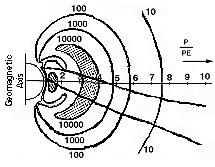(Files in red–history)
 Index Index
 10. Trapped Motion
10. Trapped Motion
 10H. Einstein, 1910
10H. Einstein, 1910
 10a. Particle Drift
10a. Particle Drift
 11. Explorers 1/3
11. Explorers 1/3
 11a. Geiger Counter
11a. Geiger Counter
 12. Rad. Belts
12. Rad. Belts
 12H. Argus 1958
12H. Argus 1958
 12a. Inner Belt
12a. Inner Belt
 12b. Outer Belt
12b. Outer Belt
 13. Fast Particles
13. Fast Particles
 14. Synch. Orbit
14. Synch. Orbit
 15. Energy
15. Energy
|
The Earth actually has two radiation belts of different origins. The inner belt, the one discovered by Van Allen's Geiger counter, occupies a compact region above the equator (see drawing, which also includes the trajectories of two space probes) and is a by-product of cosmic radiation. It is populated by protons of energies in the 10-100 Mev range, which readily penetrate spacecraft and which can, on prolonged exposure, damage instruments and be a hazard to astronauts. Both manned and unmanned spaceflights tend to stay out of this region.
 |
Cross-section of the two radiation
belts, together with the orbits of
Pioneers 3 and 4 which contributed
early observations of them.
|
The outer radiation belt is nowadays seen as part of the plasma trapped in the magnetosphere. The name "radiation belt" is usually applied to the more energetic part of that plasma population, e.g. ions of about 1 Mev of energy (see energy units). The more numerous lower-energy particles are known as the "ring current", since they carry the current responsible for magnetic storms. Most of the ring current energy resides in the ions (typically, with 0.05 MeV) but energetic electrons can also be found.
|